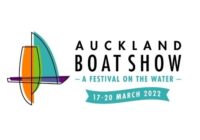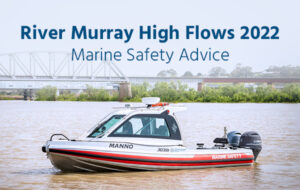
The Marine Safety SA website now has a dedicated web page to provide Marine Safety advice regarding the River Murray high flows. You can find key information about boating on the River Murray and ferry operation during the high flows. Check out the page here.
Please take additional care on the River Murray in the upcoming months. The current water flow into South Australia is approximately 89 Gigalitres (GL) per day (as at 4 November 2022). In normal conditions, the flow ranges between 40 to 60 GL per day. With significant rain falls in Eastern States and increased water flows, the Department for Environment and Water (DEW) is currently forecasting water flows of approximately 100 (GL) per day around 12 November and 135 (GL) per day by early December 2022, classifying it as a moderate flood in South Australia. Flood forecasting for the River Murray is particularly challenging and many factors can significantly affect the size and timing of the peak. This occurs differently for each high flow event.
River Murray ferry users
The Department for Infrastructure and Transport is actively monitoring the impacts of the predicted high river flows in November and December across all 11 ferry crossings along the River Murray. To view the operational status of each ferry, click here.
River Murray users
- High flows and debris can create risks for people operating vessels on the water, be mindful that with rising water levels items may become submerged under the water creating a hazard.
- Take particular care if operating near the riverbank – you may not be able to see submerged objects like small jetties which may become submerged
- Always wear a lifejacket on the river.
- Operating a vessel? Slow your speed and don’t go out if the conditions are hazardous.
- Are you towing people on the river? Watch out for hazards in the water due to the high flows.
General tips for marking vessel moorings and submerged hazards
- Check your moorings and secure them.
- Adjust moorings (including houseboat moorings) as water levels rise and fall if it is safe to do so.
- If you feel that any of your infrastructure might become submerged as the river rises, we recommend marking these to identify the potential hazard.
- Buoys can be used to mark submerged hazards or snags (e.g. – submerged jetty).
- Recommended buoy to use – yellow in colour and sized around 200mm (8 inches) in diameter.
- Please report any submerged hazards you mark via our Marine Safety SA Hazard reporting tool.
Owners of fixed or floating infrastructure
If it is safe to do so, owners of fixed or floating infrastructure have the responsibility to secure, remove or mark infrastructure on their property by:
- Considering winds and river currents before attempting to remove or mark infrastructure.
- Identifying and marking potential hazards early, if you feel that any of your infrastructure might become submerged as the river rises.
- Removing floating pontoons from the main river if possible. They should be well secured keeping in mind the increased flows and the rise of the river. Use of quality mooring lines and doubling of lines is recommended.
- Marking fixed infrastructure with a floating buoy. Recommended buoy to use – yellow in colour and sized around 200mm (8 inches) in diameter.
- Allowing for enough line on the buoy to account for the rise of the river.
Owners of houseboats
If it is safe to do so, owners of houseboats have the responsibility to ensure the safety of their property by:
- Considering winds and river currents before attempting to move or secure houseboats.
- Finding suitable mooring locations if the current location becomes unsuitable due to water levels.
- Checking that the mooring lines are suitable for the houseboat or vessel
- Moving your houseboat into slower moving water if possible.
- Not obstructing other vessels access to or from wharves, launching ramps or moorings.
- Thinking about whether you can still access the houseboat for maintenance and use.
- Making sure it does not interfere with any other mooring or property.
- Undertaking regular inspections of the condition and suitability of mooring lines and mooring location of houseboats is essential.
Stay safe if floodwaters are impacting in your area:
- Be aware that floodwaters may rise rapidly and are likely to be fast moving.
- Never allow children to play in or near floodwater.
- You should never walk, ride or drive through floodwater.
Visit the SA Government River Murry high flows 2022 webpage for links to all SA government departments, SA councils and organisations with information related to the River Murray high flows.
Hazard marking – River Murray high flows
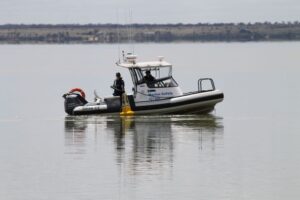
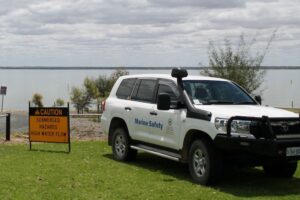
The Department for Infrastructure and Transport Marine Safety and Compliance team have been out and about undertaking important hazard identification and marking due to River Murray high flows and rising water levels. They are installing signage along the riverbank and undertaking buoyage work in the water marking hazards. Please take care and be aware that there may be submerged hazards and floating objects that are not marked. Hazards can be reported to the Department for Infrastructure and Transport, Marine Safety SA team by visiting the River Murray high flows 2022 – Marine Safety advice webpage.
Know your lifejacket
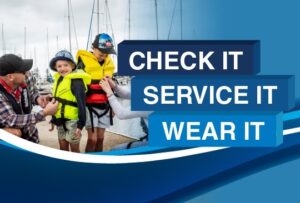
Lifejackets are the most important piece of safety equipment on any recreational vessel.
Check it – Does your lifejacket fit correctly? Do you have the correct standard lifejacket?
- It should fit snugly and not be too tight. If it is too big you might slide out of it and too small and it may not keep you afloat. Marine Safety always recommends wearing a crotch strap. Visit the Marine Safety SA website for tips on checking the fit of your lifejacket.
- New lifejackets will be marked with Australian Standard AS 4758. These lifejackets will display AS 4758 and the level of buoyancy – generally level 150 and above, level 100, level 50 or level 50S.
- Be careful if buying secondhand lifejackets. They should meet the current standard AS 4758.
- From 1 January 2025 lifejackets that meet older Australian Standards AS 1512, AS 1499 and AS 2260 will no longer be acceptable in South Australia.
Service it – Lifejackets need care and maintenance – Don’t let yourself down.
- After use, lifejackets should be cleaned and stored dry out of the sun.
- Make sure your life jacket is checked regularly for wear and tear – if it has any holes or frayed straps, replace it.
- Inflatable lifejackets must be serviced regularly to ensure they work when needed (generally once a year) in line with manufacturer’s instructions. Visit the Marine Safety SA website for tips on servicing and looking after your lifejacket.
- Find a store or service centre and sign up for service reminders for your inflatable lifejacket.
Wear it – A lifejacket could save your life. Know when and where to wear your lifejacket and stay safe on the water.
- Use the Marine Safety SA lifejacket checker tool to find the right lifejacket for your favourite activity. It allows you to choose the type of vessel and length you are operating, the age of occupants and where you are operating (the further you travel from shore means a different level of lifejacket).
Check your flares are in date
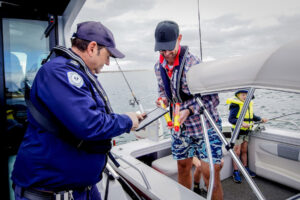
Marine Safety Officer checking flares are in date
Are you getting your boat ready for warmer weather? Boaters are required to carry two handheld red flares and two orange smoke signal flares when operating in coastal waters. Most flares expire every 3 years which means you need to dispose of them safely. Further details are available from the SafeWork SA website around flare disposal. Check exactly what safety equipment you need with the Marine Safety SA Safety Equipment Checker tool. There is a range of safety equipment required by recreational boaters. Make sure you have everything you need.
Webcams
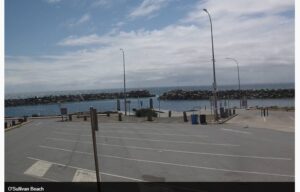
View from O’Sullivan’s Beach webcam
Did you know that the Marine Safety SA website hosts a number of webcam views at boat ramps across the state? Cameras provide recreational boaters with an indication of weather conditions and how busy a boat ramp is. Check out the webcams page here.
Current webcams include Outer Harbor, Edithburgh, West Beach, North Haven, O’Sullivan Beach and Victor Harbor (Managed by the City of Victor Harbor).
Spreading the safe boating message at Wellington
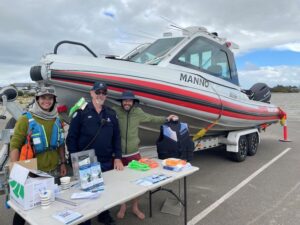
DIT Marine Safety Officer and Canoe the Coorong staff helping to promote the safe boating and paddling message
Marine Safety SA was at the official opening of the upgraded Wellington East Reserve in early October with close to 100 community members attending the day. Information was given out about which lifejacket was needed and safe boating on the River Murray. Congratulations to Sharon who won the lifejacket give away competition from Marine Safety SA. She joins our subscriber list to receive this monthly newsletter.









